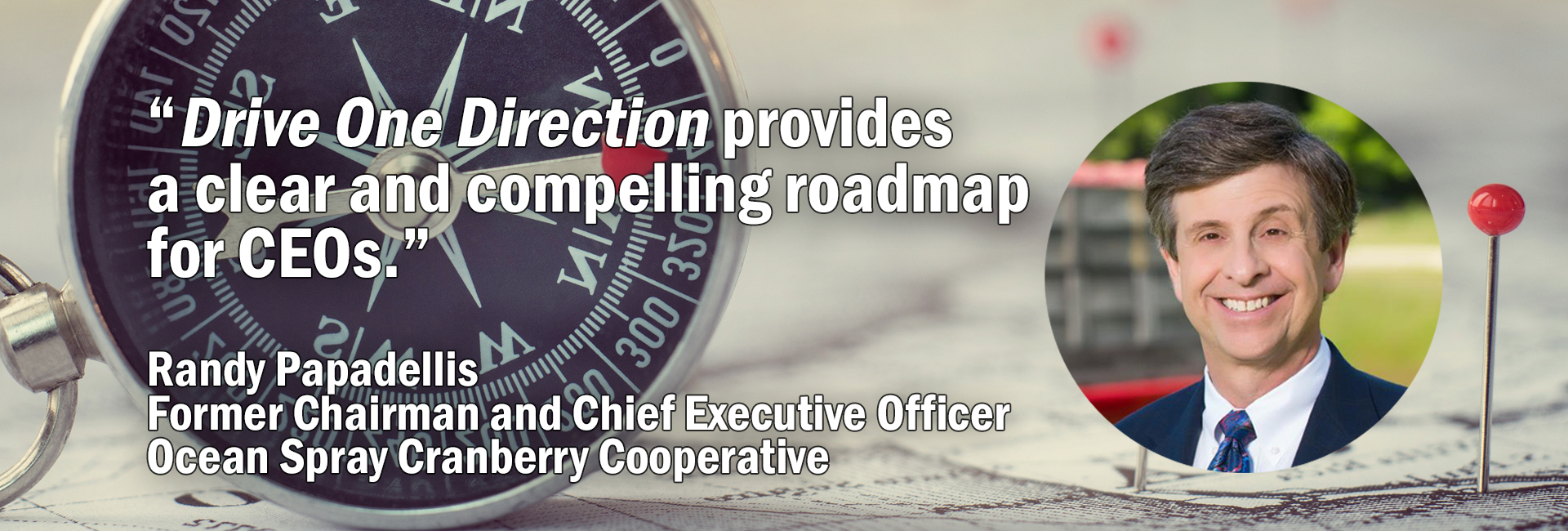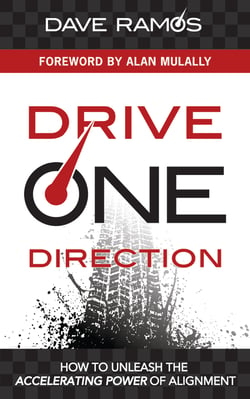DRIVE ONE DIRECTION
All of them driving in One Direction, dynamically aligned with a navigation system that can reroute the fleet on a dime.
That was the vision that inspired Dave Ramos to write Drive One Direction - How to Unleash the Accelerating Power of Alignment.
Over the past two decades, we have worked with dozens of companies, helping them improve strategic alignment. In addition, we studied over One Hundred organizations of all shapes, sizes, and industries. In particular, we focused on companies that were on lists such as FORTUNE Magazine’s Fastest Growing Companies or the various Best Places to Work lists.
Based on this work, we came to some important conclusions:
First, misalignment is alarmingly common. Virtually every company—even solopreneurs—suffers from it.
Second, organizational and societal factors have made alignment more difficult than it has ever been.
Third, strategic alignment is mission-critical. In fact, we believe that every organization, regardless of size or industry or operating model needs strategic alignment.
Consider Burning Man, the annual festival in the Nevada desert. It is designed to be the ultimate, utopian experience of individual freedom and “radical self-expression.” It attracts over 70,000 people from all walks of life (including, ironically, billionaires who fly in on private jets).
But even Burning Man has rules to keep everyone aligned.
Yes, but how about the anarchists?
The International Anarchist Federation is fighting for “the abolition of all forms of authority whether economical, political, social, religious, cultural or sexual.” Interestingly, even the IAF has rules. To become a member, you must agree to align with their statement of principles.
Amazing. Even anarchists need alignment.
So, if misalignment is alarmingly common, and creating alignment is more difficult than it has ever been, and every organization needs it, how do companies create strategic alignment?
Drive One Direction answers that question.
The book features case studies of fifty exemplar companies. Some are household names like Ford, Starbucks, and Microsoft. Some are disrupters and pioneers, like Amazon, Netflix, and Tesla. Some are mid-market innovators, such as Bognet Construction, BTI360, and Basecamp.
Our final bottom line conclusion? Alignment is the ultimate competitive advantage.
ONE WORD - ALIGNMENT
a·lign·ment
One word. Three syllables. Thousands of applications.
But, what does alignment actually mean?
The etymology origin of “align” is French. Webster’s says the first known use of the word was in 1693. Some of the common uses include:
- to arrange things or people in a straight line.
- to bring things or people into alignment.
- to bring people into agreement with a particular group, party, cause, etc.
- to bring things into a proper coordination (such as the wheels of a car).
Align is a verb. Aligned is a past participle. Aligning is a gerund. Alignment is a noun.
Okay, enough of that.
What does it mean for your company?
If your company is a global conglomerate, alignment means one thing. If your company is a dance company, alignment means a totally different thing.
In addition, our review of the research articles about alignment confirmed that even the scholars don’t have a common definition of alignment.
There are multiple reasons for this.
First, every company is radically different. Synagogues are radically different from symphonies. The United Auto Workers is radically different from the United Nations. 3M and IBM have one letter in common … and that’s about it.
Second, companies are in different life stages. Startups are worried about survival, and spinouts are worried about cutting the corporate umbilical cord.
Third, companies have different operating models and management philosophies. Some companies run like denominations, and some churches run like corporations.
Thus, every company is different, and you must define alignment in your unique One-of-a-Kind Way.
After all, how can everyone Drive in One Direction if you don’t show them the way?

ALIGNMENT 101
The United States Military has an acronym called BLUF, which stands for Bottom Line Up Front.
Here is our BLUF: Alignment is the ultimate competitive advantage.
SHIFTPOINTS came to that conclusion after studying over three hundred companies of all shapes, sizes, and industries, and interviewing over one hundred CEOs.
In addition, we read “every book ever written” about alignment and dozens of white papers and scholarly articles.
Part One of Drive One Direction introduces The Twelve Foundational Principles of Alignment. They are:
- Misalignment is an extremely common, pervasive problem that plagues organizations of all types.
- There is no standard definition for alignment … so we developed One.
- Alignment is mission-critical for every That is why we say, “Alignment is Job One.”
- Alignment is infinitely more complicated and difficult than it was just One Generation ago.
- The complexity of alignment increases exponentially as the company grows, driven by three factors: the number of employees, the number of divisions, and the number of locations.
- Misalignment is the root cause of virtually every organizational—and interpersonal—dysfunction.
- There is no generally accepted metric to measure alignment … so we developed the One-Question “Corporate Alignment Percentage™ (CAP)” assessment.
- Misalignment is extremely costly … and improving alignment might be the highest ROI activity any organization can undertake.
- Each company must create alignment in a unique One-of-a-Kind Way. This is driven by your life stage, operating model, and business philosophy.
- Alignment is primarily created at the corporate level. This utilizes the “One and Only One” model.
- Teamwork is the foundation of alignment, but you must answer the question, “What does team mean?”
- Highly aligned companies dramatically outperform their fragmented competitors. That is why we call them “fast-lane companies.”
We think of The Twelve Principles as “Alignment 101.”

THE TWELVE ACCELERATORS
The classic illustration of alignment is the rowing crew.
But imagine an eight-person boat with only seven rowers.
Or worse yet, imagine that one of the rowers is rowing in the opposite direction.
Misaligned crews lose the race. Misaligned companies lose millions.
Alignment is a complex, multidimensional problem.
Therefore, aligning your company requires an integrated, multidisciplinary approach.
Part Two of Drive One Direction introduces “The Twelve Accelerators™.” As you can see, each has the word “One.”
- One-Company Culture
- One Team
- One Vision
- One Mission
- One Code
- One Strategy
- One Thing
- One Brand
- One Way
- One Plan
- One System
- EveryOne
These are twelve components of your corporate core. The stronger your core, the more successful you will be. A strong corporate core is like a stabilizing centripetal force that keeps everyone—and everything—aligned.

THE TWELVE BEST PRACTICES
Part Three of Drive One Direction explores the twelve best practices that exemplar companies have used to unleash the accelerating power of alignment.
Much has been written about the process of leading change and the high percentage of corporate change initiatives that fail.
We believe that alignment is a special type of change. Therefore, creating alignment needs a special type of change management process.
These are The Twelve Disciplines:
-
Make Alignment Job One.
-
Run a One-Company Campaign.
-
Build a One-Company Culture.
-
Develop One System.
-
Leverage One Model: Debate, Decide, and Align.
-
Deliver One Message.
-
Apply One Process.
-
Work as One.
-
Utilize One Style.
-
Meet One-on-One.
-
Plan on One Decade.
-
Start with One Person.
If we had to summarize the process of creating alignment with just One Symbol, it would be the curly bracket. That is why we use it as shorthand for the Drive One Direction® methodology.
The Twelve Disciplines will provide the } you need to transform and align your company.
SAMPLE CASE STUDY
Drive One Direction features over 50 Case Studies of exemplar companies. This is one of our favorites.

THE ULTIMATE ALIGNMENT CHALLENGE!
Cirque du Soleil (www.cirquedusoleil.com) is a global entertainment company. It has grown from an eclectic group of twenty street performers to a private-equity-owned company with over 4,000 employees, including 1,300 artists from more than 50 different countries.
You could argue that Cirque du Soleil faces the ultimate alignment challenge:
How do you align a bunch of clowns?
Perhaps you are thinking, “my sentiments exactly!”
Every company has a diverse workforce, but Cirque might top the list. They employ actors, singers, dancers, musicians, acrobats, gymnasts, swimmers, tumblers, jugglers, divers, mimes and, of course, clowns.
In addition, they are truly an international community, which creates unique cultural and language barriers.
All newly hired entertainers go to Cirque’s International Headquarters in Montreal for preparatory training. Training can last anywhere from a few weeks to a few months.
You might think of it as Circus of the Sun 101.
Cirque’s onboarding program is a full-immersion experience. Not only do the new entertainers train together, they live together in the artists' residence right across the street from headquarters.
Every company has some kind of onboarding program. For most companies, it is “hire and hope.”
When you think of situations where life-or-death teamwork is required, most people think of a military environment like the Navy SEALs or the Blue Angels.
But Cirque’s performances involve a high degree of risk. Therefore, their “boot camp” instills a high level of camaraderie, discipline, and trust.
Having One 101 is a key component how they align EveryOne … from Day One!
Does your company have One 101 that is mandatory for EveryOne?











